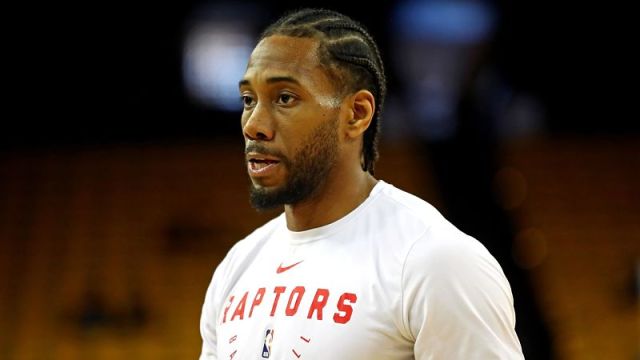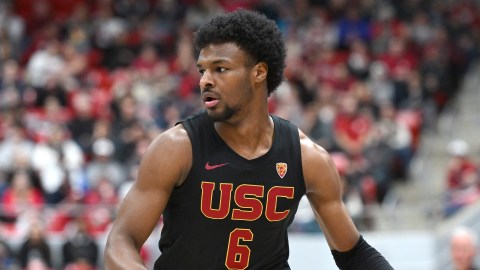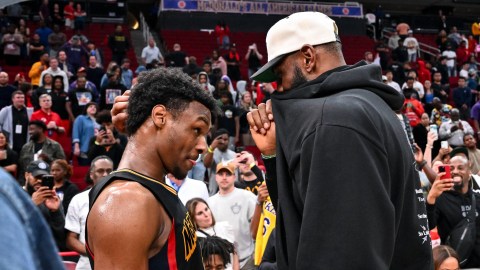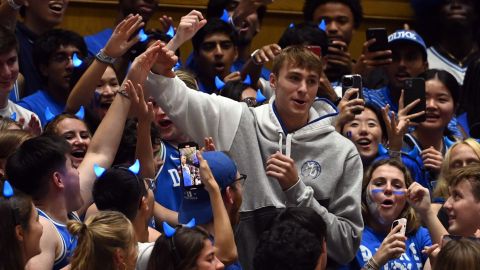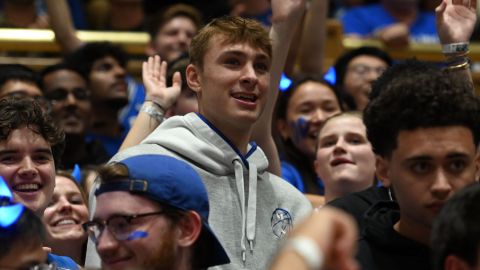The first major domino fell Saturday, as the New Orleans Pelicans reportedly traded Anthony Davis to the Los Angeles Lakers ahead of Thursday’s NBA draft.
That means the Pelicans now own the No. 1 and No. 4 overall selections, while also acquiring a young core to surround projected top pick Zion Williamson. Whether they trade the No. 4 pick remains to be seen.
A similar scenario looms for the Boston Celtics, who have the luxury of holding three first-rounders. Boston currently owns the Nos. 14, 20 and 22 selections, but it’s likely that it’ll look to shop at least one of those picks.
The Atlanta Hawks hold three first-round picks as well following a trade with the Brooklyn Nets, so there should be plenty of movement as we approach each selection on Thursday night.
Let’s take a look at who could go where in Round 1.
1. New Orleans Pelicans: Zion Williamson, F, Duke (6-foot-7, 272 pounds)
The Duke product is a never-before-seen specimen who’s as athletic as they come. Williamson was college basketball’s best player from start to finish this season, and he’ll bring that same star power to New Orleans. The 6-foot-7 forward is a no-brainer from both a basketball and a business standpoint.
2. Memphis Grizzlies: Ja Morant, PG, Murray State (6-foot-3, 170 pounds)
Morant is a fascinating prospect. At 6-foot-3, the 19-year-old has crazy athleticism, which pushes his ceiling to an extreme level. His north/south speed rivals that of John Wall, allowing him to be unbelievably effective in transition. The Murray State product should be a lot of fun alongside Jaren Jackson Jr.
3. New York Knicks: RJ Barrett, SF, Duke (6-foot-7, 208 pounds)
Barrett is a great scorer who was overshadowed by the Zion madness at Duke this season. He’s a solid passer who can act as the primary ball handler, while he’s also shown to be great on the glass for his size. Barrett is New York’s best bet at No. 3.
4. New Orleans Pelicans (via Los Angeles Lakers): Jarrett Culver, SG, Texas Tech (6-foot-6, 195 pounds)
This pick likely will belong to a team other than New Orleans, so there’s a lot of moving variables here. Don’t be surprised if Atlanta ends up with this pick.
Culver will bring great versatility to whatever backcourt he ends up in. If he’s able to improve his ball handling, he’s a sure thing at the wing.
5. Cleveland Cavaliers: De’Andre Hunter, SF, Virginia (6-foot-8, 222 pounds)
Hunter’s defensive versatility combined with his 3-and-D potential makes him an easy top-10 pick. He arguably can guard any spot on the floor thanks to his quickness and size, while possessing a consistent spot-up shot at the other end. With arguably the highest floor of any prospect in the class, Hunter can be a key part of Cleveland’s long-term rebuild.
6. Phoenix Suns: Coby White, PG, North Carolina (6-foot-5, 191 pounds)
White is extremely quick and has shown the ability to play well both on and off the ball. The 6-foot-5 guard is very dangerous in transition and is a threat for any fast-paced offense. His size is a major plus, and he’s an above-average shot maker who thrives in the open floor. In other words, NBA spacing is perfect for his game.
7. Chicago Bulls: Darius Garland, PG, Vanderbilt (6-foot-3, 173 pounds)
Garland missed the majority of the year due to a season-ending knee injury, but the score-first point guard has a perfect pick-and-roll game. Durability issues should cause White to go ahead of Garland in a class that remains thin at point guard.
8. Atlanta Hawks: Cam Reddish, SF, Duke (6-foot-9, 205 pounds)
Reddish will be the last of the Duke trio selected, but his offensive potential should keep him in the top 10. The 6-foot-8 wing certainly can score, but he doesn’t have a great motor, which leads to a lack of flow in his game. Reddish would provide a nice perimeter scoring punch alongside Atlanta’s young core of Trae Young, John Collins and Kevin Huerter.
9. Washington Wizards: Sekou Doumbouya, PF, France (6-foot-9, 210 pounds)
The Wizards are staring at a long-term rebuild, which allows them to take interest in players who are set up to be projects. Doumbouya is one of those, as the 18-year-old has plenty of upside with great length and solid mobility at 6-foot-9. He’s still very raw and doesn’t have great hands, but again, he’s only 18 and has already shown defensive promise during his time in Pro A France.
10. Atlanta Hawks (via Dallas Mavericks): Jaxson Hayes, C, Texas (7-foot, 220 pounds)
Keep an eye on the Hawks moving this pick, potentially in a deal with the Lakers to move into the No. 4 slot.
Hayes’ athletic ability and frame allow him to stretch the floor effectively. He’s still very raw and will need to work on his interior game, but an athletic big who moves well laterally always is a good start. Hayes’ game fits that of a solid modern-day rim-running center.
11. Minnesota Timberwolves: Rui Hachimura, PF, Gonzaga (6-foot-9, 234 pounds)
The Japanese-born forward has an interesting skill set, which creates plenty of mismatches for opposing teams. Hachimura is athletic for his size and exemplifies great work ethic that any team would love to add.
He’s still a raw talent with plenty of room to improve, especially in the speed and interior departments, but he’s trending in the right direction. A versatile big man next to Karl-Anthony Towns will be tempting for the Wolves. This may be a bit early for the Gonzaga product, but it would be a good fit.
12. Charlotte Hornets: Brandon Clarke, PF, Gonzaga (6-foot-8, 210 pounds)
Clarke is a defensive-minded forward who is ready to contribute immediately at the NBA level. He uses his strong basketball IQ and unique skill set to his advantage on both sides of the ball. If his pick-and-roll game translates to the professional level, he’s one of the more NBA-ready prospects in the class.
13. Miami Heat: Nassir Little, SF, North Carolina (6-foot-6, 215, pounds)
Little is an explosive wing who underperformed for the majority of his season at UNC, but he still has great upside. His toughness and strength allow him to defend multiple positions, giving him 3-and-D potential.
14. Boston Celtics (via Sacramento Kings): Tyler Herro, SG, Kentucky (6-foot-5, 193 pounds)
Herro can knock down shots from anywhere on the floor and is a good defender. He can’t yet create his own shot, but ideally, a good system like Boston’s will help that come to form.
He had a tremendous workout with Boston, which has reportedly taken a liking to the Kentucky product.
15. Detroit Pistons: Romeo Langford, SF, Indiana (6-foot-6, 202 pounds)
Langford didn’t have a great 3-point shooting season, but much of that likely was the result of an injured shooting hand. To his advantage, he’s a great scorer, extremely athletic and has a good frame for an NBA wing. There’s no reason to believe he won’t be a pro bucket-getter, especially if he can create his own shot in pick-and-roll sets.
16. Orlando Magic: Nickeil Alexander-Walker, SG, Virginia Tech (6-foot-6, 200 pounds)
The 6-foot-5 guard can play on or off the ball, which is a huge improvement from where he was during his freshman season with the Hokies. His length, high IQ and creative scoring ability could make him one of the biggest steals of the draft if he falls.
17. Atlanta Hawks: PJ Washington, PF, Kentucky (6-foot-8, 223 pounds)
Washington benefited from returning to Lexington for his sophomore year. He plays like a guard but is 6-foot-8 with a 7-foot-3 wingspan. Not bad for someone with solid court vision and an awesome ability to find the open man.
18. Indiana Pacers: Keldon Johnson, SF, Kentucky (6-foot-6, 210 pounds)
Johnson is a really hard worker who’s a plus defender with a smart offensive game. His off-ball flow needs improvement, and he has below-average athleticism, but Johnson’s effort and talent alone lead people to realize his potential as an immediate impact player.
19. San Antonio Spurs: Cameron Johnson, PF, North Carolina (6-foot-9, 210 pounds)
Floor spacing is important in the NBA, and long shooters make it much easier to achieve. Johnson is exactly that, in addition to having a strong transition game. At 23, he’s one of the older prospects in the class and should contribute immediately.
20. Boston Celtics (via L.A. Clippers): Kevin Porter Jr., SG, USC (6-foot-6, 217 pounds)
Porter Jr. is a lottery talent with a plethora of concerns. Injuries and a lack of work ethic will keep him from the top 10, but this kid can score. If he pans out, he’ll be an absolute steal.
The Celtics are a team that isn’t afraid to take a chance on a young player with some high upside. Last year, they selected Robert Williams, a lottery talent who fell out of the top 14 due to durability and work ethic questions. Danny Ainge could make a similar selection in 2019.
21. Oklahoma City Thunder: Goga Bitadze, C, Georgia (6-foot-11, 251 pounds)
At 19, Bitadze (from Georgia, the country) has shown the ability to play against high levels of competition. He can effectively stretch the floor, but is he the next Nikola Jokic? Who knows. International scouting remains a mystery.
22. Boston Celtics: KZ Okpala, SF, Stanford (6-foot-9, 210 pounds)
If he continues to improve his perimeter game, Okpala’s impressive athleticism could make him a hybrid 3-and-D player. Good court vision and solid basketball IQ with good passing ability sounds like a nice combination, right?
Boston certainly would be willing to take a flyer on an athletic big who can stretch the floor.
23. Utah Jazz: Ty Jerome, SG, Virginia (6-foot-5, 200 pounds)
Jerome is a pure shooter who can play multiple spots. At 6-foot-5, he provides defensive length needed from guards in today’s NBA. That and his playmaking ability give him a game fit for the pros.
The Jazz need shooting, so this seems like a good match.
24. Philadelphia 76ers: Talen Horton-Tucker, SG, Iowa State (6-foot-4, 239 pounds)
Versatility is the key factor with Horton-Tucker. His size allows him to guard multiple positions and fill different roles on the offensive end. His age (18), ability to shoot off the bounce and length combine to make him a fascinating prospect.
25. Portland Trail Blazers: Bol Bol, C, Oregon (7-foot-2, 222 pounds)
This is much lower than where Bol is looking to go, but the red flags are just too much. Yes, he can shoot from deep and is a great shot blocker, but his motor is very concerning alongside his questionable durability. The Oregon product has a lot of offensive upside but will need to convince teams that the concerns aren’t as alarming as many feel they are.
Don’t be surprised if someone takes a flier on him in the late teens, but he should fall out of the lottery, where he originally was projected prior to a left foot injury.
26. Cleveland Cavaliers (via Houston Rockets): Luguentz Dort, SG, Arizona St. (6-foot-5, 224 pounds)
Dort can defend bigger guards along the perimeter, while also sticking with quicker ones when given that challenge. He’s very strong for a two-guard but will need to show some versatility on offense in his pre-draft workouts to help his stock.
27. Brooklyn Nets (via Denver Nuggets): Grant Williams, PF, Tennessee (6-foot-6, 221 pounds)
He’s not a great athlete and isn’t a deep threat (yet), but Williams is a team-first guy who plays his butt off. The 20-year-old is as tough as nails and his defensive IQ will help any club.
28. Golden State Warriors: Carsen Edwards, PG, Purdue (6-foot, 196 pounds)
Those who watched the NCAA Tournament know what Edwards can do.
The 21-year-old can play on or off the ball, and his range extends to the parking lot. He’s a bit undersized and hasn’t shown great playmaking ability, but he projects to be a solid backup point guard wherever lands.
29. San Antonio Spurs (via Toronto Raptors): Matisse Thybulle, SF, Washington (6-foot-5, 200 pounds)
Thybulle is an outrageously good defender at 6-foot-5 and has the ability to disrupt any level of guard along the perimeter. At 22-years-old, he’ll be ready to make an immediate impact as a high-level defender wherever he lands.
30. Milwaukee Bucks: Dylan Windler, SF, Belmont, (6-foot-7, 195 pounds)
Windler is a great shooter who could fall into the early second round, but if a team utilizes him correctly, he’ll be extremely useful for any organization’s perimeter depth.
